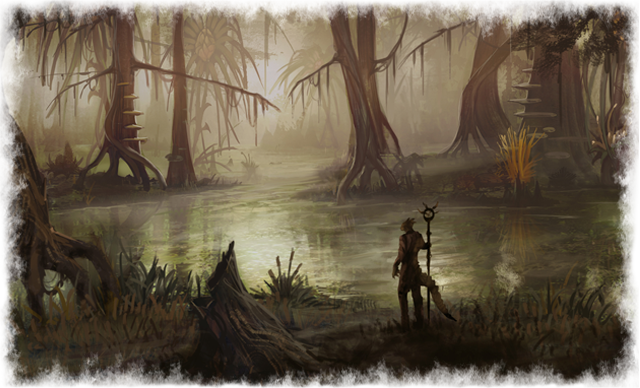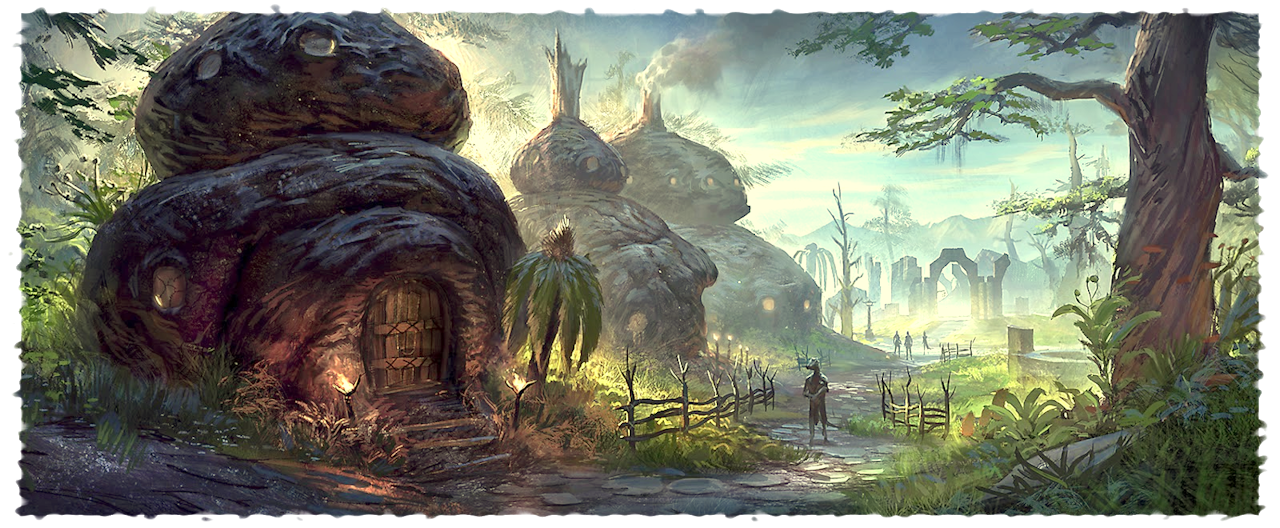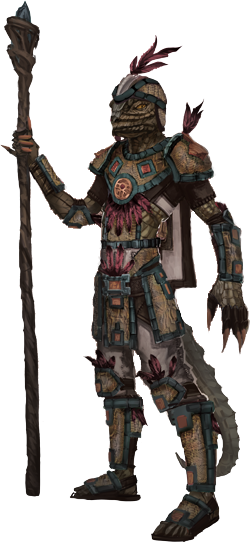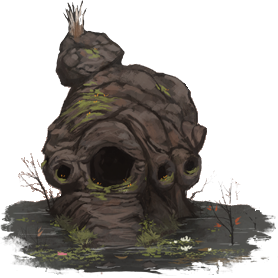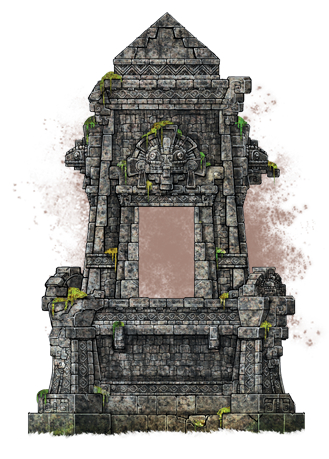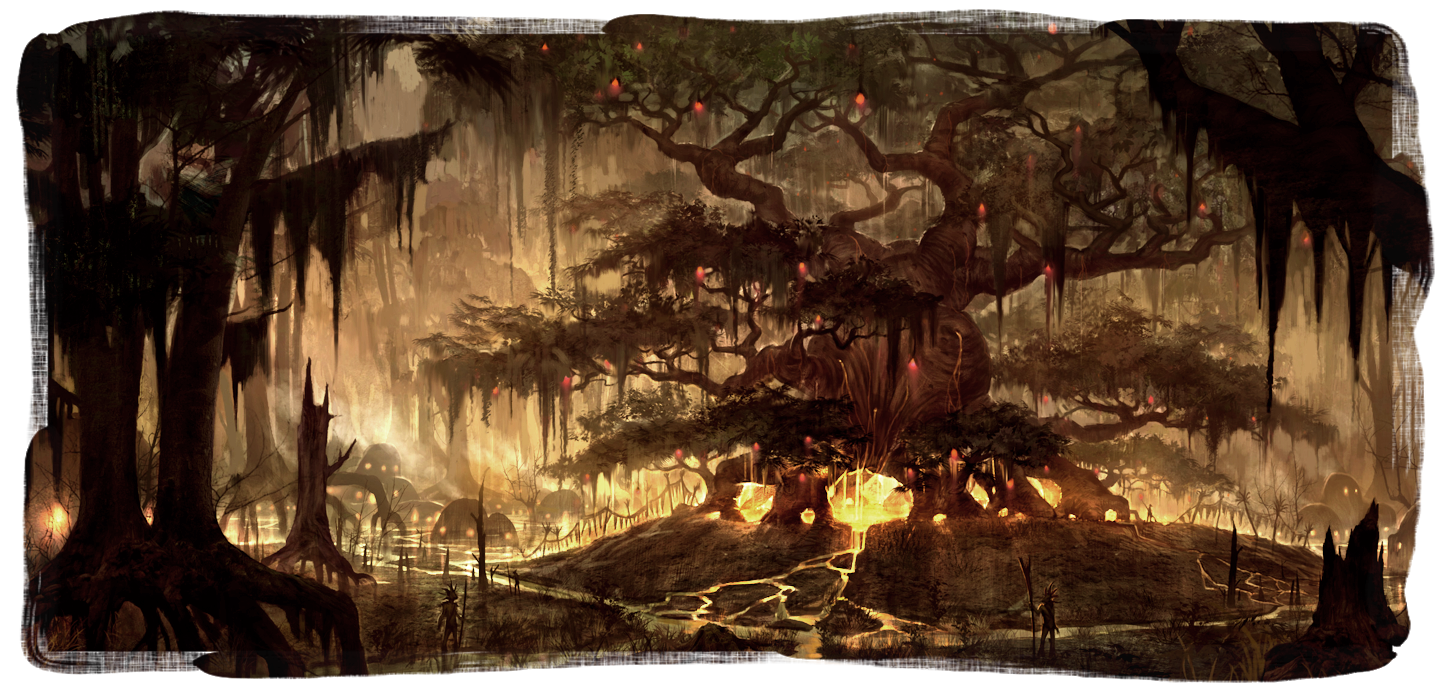Original media : The Elder Scrolls Online Imperial Edition
By Flaccus Terentius, of the Imperial Geographic Society, 2E 581
Black Marsh
Argonians of the Ebonheart Pact
Meeleeh-Een is a thing, cheerful reptile whose demeanor soured only when I referred to him as an «Argonian». Apparently, in these parts, they prefer the term «Saxhleel», but I'm going with the Imperial term anyway. He's been temporarily assigned to my protection as I head to Stormhold and a meeting with Vicecanon Heita-Meen. I might as well burn the guide chapter on this province, as Imperial geographers seem to have circumvented this entire swamp and used imagination instead. Little truth is really known about this place.
D uring the Second Empire, the vast swamplands encompassing Black Marsh were claimed as Imperial territory. Naturally, the obtuse Elves (and other admirers of this seeping pustule on the buttocks of Tamriel) favor the name Argonia, an ancient battleground where their forebears were put to death. Perhaps because of this, it was deemed appropriate to give the primordial tribes of lizard-folk the name «Argonian» in our common tongue. What cannot be argued is the pitiful state of this province; it positively oozes with the devastated and fetid: The scars of battles past and plunderers present permanently disfigure these already-inhospitable borderlands. Wade inward, though, and the dark heart of Black Marsh will elude you; its elements combine to infect explorers with poxes both real and imagined.
The inhabitants of this province enjoy an anonymity not seen elsewhere. The early Aldmeri explorer and poet Topal the Pilot described «manlike reptiles, fleet of foot and running the length of this great mire», and gave the impression of an abandoned place, unlivable to settlers. However, primitive Men such as the Kothringi, primal Mer like the Barsaebic Ayleids, and relatives of the Khajiit like the vulpine Lilmothiit all fought for their own pieces of this noisome refuge.
|
|
The dismal, noisome, oozing, dreary, viscous, sodden, reeking swamps of Black Marsh.
|
|
The curious mix of architectures in Stormhold.
|
The instant I spotted Vicecanon Heita-Meen in her administrative office, I recognized her pointed snout and the concentric patterns of the clasps of her battle armor. Her likeness was present in the painting of the Ebonheart Pact I appropriated from Kragenmoor Manor library, back in Morrowind. Although her quarter in the rather shambolic Stormhold lacks the immense fortifications and wondrous architecture of other capitals of Tamriel, this is forgivable due to the recent circumstances.
Heita-Meen, under her magistrate title of Vicecanon, was occupied with judgments against two bitter-looking Dunmeri from the recently suppressed House Dres. To think, less than a generation ago, I could have selected an Argonian for my own whims. No more; the Dark Elves were convicted of slave-trading and sentenced to be hung in cages attached to the Ayleid arches for a year. Should they somehow survive this fate, they face exile from Black Marsh. My Argonian friend, Meeleeh-Een, referred to them as «dryskin fools and withered roots», not a term of endearment, I'm sure.
«Stay moist,» Meeleeh-Een said in farewell.
I mperial scholars note the Battle of Argonia and conquest of Black Marsh in 1E 2811 -- the first time a race of Man properly held power in these parts -- but fail to mention the impassable denseness of the geography. Imperial Scout Tutor Acilius describes the swampland as «a soup of suffering and disease, where a drop of ingested ground water can set off a torrent in the bowels». Given the difficulties of the interior, the Empire was content to incorporate the northern and western borderland regions. Indeed, it was these coastal tracts, where Tamriel's delinquents once freely roamed, that were changed into barely habitable prison settlements. It is not surprising, then, that a separate but comparable history of indenture exists elsewhere in this great morass: Stormhold.
Founded by the Barsaebic Ayleids before parchment records were kept, Stormhold holds the infamous history of the Dark Elf. Primal wealth is still evident on the intricate stonework of the Ayleid ruins, and the more recent Dunmeri stone structures show what venomous and uncaring rule can build. Abutting these monuments to greed and cruelty are the more modest huts of the Argonian contingent, once the homes of the collaborators -- who worked with the Dunmer to raze primitive villages and gather suitable captives for plantation work across Morrowind -- and now home to the reptilian race only now finding their way out of the mire of oppression.
As thuggery encroached on Stormhold during the upheavals of the Second Era, and the dark Dunmeri chains of bondage -- as well as irregular Imperial warlords driven to distraction with thoughts of bounty and easily exploitable labor -- threatened to wipe every last tribe of Argonian from the province, there was little the exploited reptilians could do. Until, that is, the rise of the Argonian Vicecanons, who seem to fulfill the administrative functions that councilors and tribal leaders do in other realms.
|
|
Argonian scout in light armor
|
«An Imperial presence here is approved,» Heita-Meen stated as she beckoned me with a flick of her spindly wrist, a gesture that belied her combat adeptness with a staff. For a few moments, I felt she spoke disdainfully with me, until I realized this wasn't simple rudeness; all of her race addressed me with a detachment that was antithetical to my formal upbringing where manners mattered.
«Lonely-Spines, an egg-brother to assist you with your progress.» She gestured to a young Argonian who was to escort me around Stormhold. He explained he was a former slave (or as he put it, «a choking vine rootbound in the soil of our homeland, now free to bloom»). His lilting tone was both annoying and strangely comforting, although he spoke no Jel -- the lizard-tongue of his progenitors -- as he was a product of an unpleasant upbringing on a Morrowind saltrice plantation. He explained he was a Lukiul Argonian and already assimilated in the ways of Tamrielic matters. He warned me of the Saxhleel, who were traditional Black Marsh inhabitants and rightly suspicious of visitors. I hoped we'd encounter more of the Lukiul as we set off toward the town barracks.
We watched a Nord sergeant -- thickly built and dripping with perspiration from the head -- drilled a set of fluid and impressive combat maneuvers with a recently formed company of Shellbacks, the infantry troops of the Argonians. Lonely-Spines motioned for a reptilian fellow watching from the barracks wall, an Argonian captain and veteran of the Akaviri campaign, overseeing the melding of battle tactics. He had a furrowed brow and a deep scar where one of his eyes had been. As the maneuvers became more coordinated, Lonely-Spines explained the Shellbacks were being trained to stand firm next to Nord and Dunmeri heavy infantry units. Up until this point, I'd thought Argonians excelled at scouting and light skirmishing in Pact matters and hated fighting in formation. These lizard-folk are more adaptable than I expected.
Ha! Some bigoted and outdated nonsense from an Imperial armsman. And to think I used to believe this foolishness!
Y ou might as well believe a Dark Elf will worship Mara as to think an Argonian blacksmith could create arms and armor without an intrinsic and primitive crudeness. Uncomfortable to wear and difficult to hold, their armor and shields seem to be a sewn collection of natural materials -- reptilian hides (hopefully not a cousin of the smith), strange green-tinted stones called jadeflint and obverdian, bog iron, and steel with a rough copper alloy edge. It is a wonder these don't collapse at first impact. Perhaps the sweltering climate prevents more intricate designs from being forged? These primitive trinkets pale in comparison to the advanced forging techniques of the Empire. Even a Nord would look down his frostbitten nose as such armaments. Little wonder these swamp creatures languished in bonds for centuries.
Much of this is partisan piffle: Having held a shield, it fits together with precise -- albeit thick -- tamarack wood and expertly draped wamasu hide. I'm told this is thanks to ancient techniques that involve hardening or enhancing the flexibility as the need arises. Apparently, our artisans know little of this innate cleverness.
|
Our disdain for Argonian battle equipment is most misguided. As I watched the Nord and Argonian officers square off to show their recruits a dull-bladed duel, I was impressed at the dexterity and lithe skill of the supposed primitive. But it was his crocodile armor that was easily a match for the Nord's best thrusting attempts.
I was far less enamored with Argonian architecture. While other cultures have gleaming temples that celebrate the grandeur and aspirations of Man or Elf and are built to last the centuries, the atrocious mud huts I had the displeasure of staying in seemed to be actively disintegrating into the oozing swampland. These are wattle-and-daub in construction. But even a Breton knows a foundation of stone is superior to this wet loam. Lonely-Spines pointed out that Argonians really like this "sun-blessed" mud. And also feathers: Not a step can be taken before another tribal totem of wood, mud, and plumage rears up at me like a malformed golem.
I might be the first outsider to sketch the heavy armor and weapons of the Argonians in such detail. Perhaps this might persuade disbelievers of the reasonable sophistication of this equipment. The melding of reptile hide, metal, shell, and bone is both tough and lighter than steel armor. The advantages are numerous, but all the proof I required was displayed as I watched lizard-folk swimming, seemingly unencumbered, in this attire. Lonely-Spines offered «an oozeworthy opportunity» to try splashing around myself, but I politely declined. I'm already coming down with an unsettled gut and a phlegmy cough.
|
The malodorous mud nests of the Argonians remind me of insect hives.
|
After a night in Lonely-Spines' mud hut, I can safely report that Argonian hut architecture is just as disgusting as it appears in these sketches. The walls tend to sweat in high humidity (which is, naturally, all the time) and that incredible odor! It makes one wonder what these lizard-folk use for a binding material. I'm never one for idle speculation, but I'm reasonably certain I spotted dry excreta mixed into the sealing at the edges of windows.
My remit requires a thorough exploration of every locale I deem important to future Imperial affairs. I was to venture into the deep marsh, where the Knahaten Flu still lurked. Lonely-Spines was reluctant: «Beware, for you swim in Trouble River.» After a protracted negotiation, my powers of persuasion (and the bartering of coin and a genuine Tu'whacca prayer wheel) won him over. Tomorrow we venture to the Argonian hatching pools, where I am determined to inspect one of the legendary Xanmeers -- strange pyramids built by the Saxhleel in unknown times past -- and sketch the big Hist tree.
I n other Imperial territories, a multitude of settlements and indigenous artisans are ripe for exploitation. Not so the Argonians. This province differs considerably, as the lizard-people seem to have no desire the construct sprawling cities. Oddly, every populated area, from the simple township to the sprawling city, was built by foreign conquerors on the scaly backs of Argonian serfs. Visit Gideon and Blackrose perchance, and gaze at the Imperial architectural influences, whereas in Stormhold, Dunmeri structures form the foundation of this capital.
Why don't the Argonians build their own permanent structures? From expeditions of the Second Company of Knight Paladin Reconnoiters, it seems their forebears did just that. Rumors abound of ruined Argonian cities, great walls, and pyramids. Stone statues both small and grand dotted across the backwaters of Black Marsh, their grandeur left to fester and slowly sink. Current Argonian dwellings are unrefined dollops of muck with none of the primitive intrigue. This is made all the more jarring by the fact that lizard-folk still live among these older stone ruins, maintaining them from complete disintegration. It is discordant to see the degraded modern lizard-man slithering among the ruined debris of a more civilized time.
Well said! I'll be keeping this description -- possibly using even stronger terms. Disgusting? Repugnant?
|
Our soggy sojourn shall commence by dawn: Lonely-Spines has just spent the day gathering the necessary equipment for the trek into the Deep Marshes while I attempted to waterproof my Nord boots and tended to the blighted patches of my toe fungus. Draining those pustules was a simple affair. Then, I quickly cracked open my paints to sketch some of the collected baggage of our small caravan. A depth stick was most welcome; we could now fathom which fetid pond was in a fact a small puddle and which would swallow us to our necks. Dried flower buds would serve as water purifiers, as the swamp effluent I'd been wading through wasn't fit to stand in, never mind ingest. Lonely-Spines also returned with a Lukiul tent. He explained «a dryskin like you probably doesn't want to burrow into the mud at night». What a perceptive fellow he is.
I waterproofed my best Nord boots for this? My initial meandering away from Stormhold (toward the delightfully named Bogmother) was on ground firmer than a Breton thoroughfare, a stone-flagged road, or causeway, between the unrelenting wetness I've been assured was ready to swallow us soon. Lonely-Spines has gifted me with a vile-smelling emollient to apply to my forearms, face, and other exposed extremities. It apparently has properties to keep the fleshflies away. While this is indeed true, now only the larger insects dare to bite me. Something winged and iridescent found me delicious already.
T he earliest explorers of Black Marsh spoke of proto-lizards with a humanlike gait, although no records show the origins of this species. Certainly, there was none of the disdain or pity that many of the Empire's subjects hold for the modern Argonian. Myths persist that paint them as fearsome savages, raiding small communities for trinkets and meat. Others speak of them almost as a curiosity, slipping from their miasmic bayous for brief, mostly nonviolent incursions.
The early First Era scholar Brendan the Persistent noted a range of differing views, «from deep suspicion and confusion through breathless veneration to abject horror». He continues: «The Argonian people have, throughout Tamrielic history, been perhaps the most misunderstood, vilified, and reviled of all the sentient races. Yet, those who have taken the time to experience Argonian culture have gained a greater appreciation for this noble and beautiful people.» It should be noted that the historian disappeared during his final expedition into the deeper swamps of Black Marsh.
|
U ntil the latter part of the First Era, Argonians were a quiet people, content to step into a subservient role and lose their identity amid the larger cultures of Tamriel. This was until the infamous Raid of «Red» Bramman in 1E 1033, when Empress Hestra dispatched the Imperial Navy to pursue and capture the crimson-haired pirate. Traveling up the winding river east of Topal Bay, braving thickets, pox-carrying insects, and humidity, the skirmishers tracked and beheaded Bramman within his brigand kingdom, close to the settlement of Blackrose. On their return to the empress, crew members spoke of the true culture of Black Marsh for the first time.
The Argonians distrusted men after witnessing Bramman's antics of pillaging and slavery. They resisted the Empire's efforts to encroach into their land along the old pirate routes, and exploration halted as the First Empire waned. Black Marsh was finally claimed in 1E 2811 after the Battle of Argonia, and the reptiles were routed to Helstrom. Coastal towns and the safer parts of the interior swore fealty to the emperor, and the native lizard-men were pulled deeper into the swamps. Black Marsh flourished and gained a rightful reputation as a jettison for criminal elements, and the land's most famous convicts were sentenced to sweat and toil in these mangrove swamps. Little wonder, then, that the indigenous locals express a lack of trust and enthusiasm for their neighbors.
The feeling is mutual!
|
We made good time despite the bites and humidity, and the smell of fleshfly repellent was finally beginning to fade as we approached Bogmother. The moss-draped trees and grassy knolls were alive with a thousand unseen insect musicians. Masser lit the crumbling ruins of this fallen temple village, which once seemed a more mighty and proud place. There were unexpected intricacies in these ancient towers. Strange figures. Unknown gods? Lonely-Spines had no learning to impart. My painting shall be guesswork.
My anger and anxiety have risen now that my favorite easel rests halfway down a crocodile's gullet. I had set to paint at the edge of Bogmother -- clearly well within the town's threshold -- and was finishing some preliminary sketches (now lost) when something lurched up from the stagnant water at me: As long as two men are tall, this sharp-fanged fiend immediately went for me with amazing speed. A lengthy snout and thick teeth clamped the air where my leg had been. Paints, brushes, and parchments went flying. Lonely-Spines was indisposed as the latrines, so I fended off the two snapping attacks with a hodgepodge of dexterity and panicked screaming. Than I force-fed the beast my art stand until it slithered off. How can the lizard-folk put up with such attacks, practically in a citified area? Why are there no town guards?
A rgonians spent much of the Second Era under the tightening bonds of Morrowind's slave traders and wayward Imperial warlords, as the instability of Tamriel furthered exploitative practices and banditry. Although turmoil affected both Man and Mer, none were more downtrodden than those of reptilian form. Then came the Knahaten Flu.
We may never know the origin of this plague, but the aftermath is not in question. Originating in Stormhold in 2E 560, it soon spread to every damp nook of Black Marsh, and for years it held this province in its diseased grasp. Foreigners fled or faced a death most bloated and painful. Entire cultures were wiped out, most notably the Kothringi. But it is said not one of reptilian stock was infected.
|
|
Obelisks, cenotaphs, and stelae of the deep marsh
|
I refocused my sketching efforts and wasted no time inspecting the ruins of Bogmother still further. The ruins are both immense and rambling, and I can almost hear the rasping cries of Lonely-Spines' ancestors echoing off the cenotaphs and barbicans. As Lonely-Spines puts it, «My forebears still whisper here, like the swaying marsh reeds at Last Seed». Most glorious of all this carved stone i the dominating stepped pyramid, or «Xanmeer». The entire area is «Xal», or «sacred» in the rasping tongue.
A fter studying texts and illustrations and the encounters in Blackrose, Second Company lorekeeper Coventina Helvetia went on to explore the intricacies of Argonian architecture. She postulates that the feebleminded, shackle-wearing vassals currently infecting this land with the flu could not possibly have invented and sculpted the squat but highly ornamented stone monuments. It strains credulity to agree that such edifices were works of Argonians at all. Current speculation is that an indigenous human tribe known to be active in this region -- such as the Kothringi or Yerpest -- was responsible. This tribe, in turn, took inspiration from the architecture of Barsaebic Ayleids. Then, via disease or strife, the scaly men of Black Marsh salvaged these earlier settlements and claimed ownership. Yes, here, perhaps, lies the truth in the matter.
|
We were now deep in the mucky wilderness of Shadowfen. As I applied ointment to lessen my chafing, I remembered reading about the legendary Argonian hatching pools. I inquired further.
«We are quite close. One is only as far as the territory of a crocodile. But Lonely-Spines thinks you may return with despoilers. There is no moisture in this choice.» The help, it seemed, was acting up again.
«Look, I've already traded a Tu'whacca prayer wheel -- a genuine one, mind you -- for services beyond your remit. You've had my coin and companionship. I've even endured your nature allegories. We journey to the Hist tree at once.»
«I am dry with vexation about your choice,» came the reply through a curled-up snout.
«Then wet your feet as we wade to our destination,» I replied, tossing him a few more coins. We were soon splashing our way to the most sacred glade of Black Marsh.
Imperial Second Company's knowledge regarding Hist trees: A collection of half-remembered myths and rampant speculation, although there may be something in those Dunmeri translations.
T hose willing to risk rust chancre, greenspore, and a host of other more debiliating diseases may venture into parts of Black Marsh unmapped by the higher races. The few who can cope with swamp rot, fleshfly bites, and the constant palaver or unseen entities whooping, clicking, or simply lying in the murk waiting to slice teeth across their limbs may reach the innermost swamps. And the hardiest of Imperial explorers, who have no further need to prove their mettle after the following discovery, gaze upon the Hist tree.
Rumors abound that the Hist tree is the main object of worship among the scaled peoples of these dark swales. Others have hypothesized that the trees are apperceptive, with a deep knowledge and unfathomable secrets from the times before all races of Man and Mer. Loose translations of recently uncovered Dunmeri texts seem to indicate a ritual among the Argonians, although this may be legend rather than fact.
It is said that when a Saxhleel emerges from juvenescence, it finds a nearby Hist tree to lick sap from its bole. The elements in the sap quicken the hormonal glands, which sprout appropriate organs from which the Argonian's gender can be determined. Immediately afterward, an appropriate mate is found and reproduction occurs. The female soon lays one or more eggs, which are moved to a hatching pool where gestation and spawning takes place.
With recent Imperial expeditions into central Black Marsh ending inconclusively (burial sites were marked on the map Cornix Ceaparius provided), and the locals reticent to speak of the mysteries of this fabled tree despite our cajoling, we remain alarmingly ungifted in the realm of Hist tree knowledge.
Head horticulturist Titullinia Petillia of the Imperial Palace Gardens has requested careful handling and collection of sap or seeds from this tree, should one be discovered. It may prove to be a considerable boon to our apothecaries.
|
|
My time coping with bloated insects and an indolent Argonian was justly rewarded with a painting of the magnificent Hist tree of the hatching pools.
|
«Xuth. Intruder.» An Argonian Keeper guarding the perimeter of the pools raised his voice and his spines at me. He made invocations to the mire, and it began to churn beneath his feet. Out of the marsh came a cloud of what looked to be strange spores that circled around the Keeper's head. I hastened a necessary retreat. Thankfully the Keeper turned his attention to Lonely-Spines and said, «Eventually we all feed the roots of the Tree. Is it your turn?»
Moments later, my Argonian escort had fallen to his knees, writhing in a storm of spores.
Again, you must pardon my recollection at this point. I was confused, worried for my own skin, and blundering in the dark. As Lonely-Spines was dragged away, I panicked and made for our previous camp. Failing to find the way, I staggered, bewildered in the dark.
|
The horrible Wamasu - it almost seems more Daedra than lizard.
|
Next I saw a bluish, flickering light. I yelled for help and stumbled toward it. As I viewed the origin of the illumination, I leapt for drier land. This was no lantern, but an intermittent electrical discharge from the spine of a huge and gnarled lizard the size of a fallen tree. Luckily, Arkay failed to summon me. The dragon-thing was thrashing and gnashing at three of the largest wasps I'd ever seen.
T he wamasu -- a giant, lumbering «swamp dragon» or a dubious myth from the snapping mouths of lizard-kin to further dissuade visitors to Black Marsh? Secondhand evidence is questionable. Sotild Blood-Rood's expedition from Skyrim is our best resource, and she writes of her unfortunate encounter with such a beast:
«It reared from a thick black pool, and our champion sought it. Its face. Shaped like the skull in Dragonsreach. We thought Alduin himself had spawned! But no wings and no intelligence; this is a low beast. Large and hungry, it flailed and sparred with Heidmund for a few moments as we roared with blithe approval. Then, in an instant, Heidmund fell, flashes and sparks of energy consuming him and our party and cursing all the water to deadly convulsions. All were lost, and for the first time in my life, I entertained the thought of retreating from combat.»
|
Panic. Lost in the endless marshes. I felt the branding mark throb.
The wasps halted their pursuit as I reached a strange and forlorn glade. I instinctively shivered as the moisture seeped into my bones. Bereft of warmth, I gazed at three dancing lights, strange wisps that flickered and darted about my quivering body. Then a figure. A wonderful, graceful female form, coalescing from these indistinct vapors. I reached out to her. She beckoned me to her. I obliged in my befuddlement, seeking an embrace. Her kind eyes...
I clutched my chest as freezing pain seared through it. I watched the woman grimace, contort, and fall away into a twisted vision of snarling hate. Was I to die here? No. A high cackle vibrated between my ears. I half turned around to look for the source but knew the culprit already. Mannimarco was tormenting me even here. I shook my head but could not dull the dark puppeteer's laughter within my skull.
I splashed deeper into the mire and despaired.
A nother legend of the dark swamps of Argonia concerns wisps. Imperial scouting parties stationed in Blackwood have numerous reports involving strange orbs of light that slowly meander the marshlands. Warnings were posted across the realm after Captain Vlastarus Flantus was lured to his death by their mesmerizing glow, strange illusions, and his inadequate swimming skills.
Witnesses claim these wisps are no mere congregation of swamp vapors, but something intelligent and altogether more frightening, a minion controlled by an uncanny and powerful anchor: the wispmother. She may be a ghost or a wraith or a nature spirit. Aside from a tendency to appear close to areas of great magic, little else is known of her, including the nature of the wisps she seems to summon. Beware.
|
There was silence, then a rush of blood to my temples. I took a few unsteady but purposeful paces toward an embankment. I had found a strange shrine... to a serpent god? I had just begun to sketch when the biggest snake in Black Marsh darted toward me. I instinctively fled and, by Stendarr's mercy, scrambled to a pathway.
I was catching my breath when two thin, cowled figures approached from out of the low mists. A scaly hand was held to my face.
«Imperial slaver scout, you seek to tarnish our foliage with your mildew.» This rasp was menacing. Red and black garb, and blades glinting off their torches in the early twilight. I half hoped the snake might arrive to aid me.
«A simple mistake. I am Envoy-Scholar to the--»
The hooded Argonian beckoned me to within a whisper's distance: «We know.»
«Then I demand you unhand me and--» An ebony blade appeared at my throat, and a second pointed decidedly lover.
The Shadowscale responded with a hiss: «I have heard that if an Imperial loses an appendage, it does not grow back. Shall I test this?»
Unfounded Imperial evidence regarding the serpents frequenting these marshes.
M any seething terrors share Black Marsh's waterlogged inlet bogs with the half-breed two-footed reptiles. Infiltrators of the swamps must be at the ready to encounter the giant ophidians of Argonia. The abundance of prey and lack of competent predators -- aside from the snakes' use in the armor of the lizard-folk -- have led to colossal specimens. When elongated, some have grown as a dozen cattle laid end to end. Servants' notes of the late Imperial botanist Angelus Hortensius indicate he was caught in the gaze of such a slithering fiend and suffered the mortification of being swallowed whole. He endured numerous puncture wounds and the loss of an arm and had to extricate himself by using dagger thrusts from within the snake's belly, but he expertly tended to his wounds due to his personal herb collection. Unfortunately he was too weak to move and soon expired after being swarmed by fleshflies.
|
I was traipsed back to Stormhold to answer for my supposed crimes. I should be thankful I wasn't murdered before the Shadowscales sought to substantiate my story. But Vicecanon Heita-Meen vouched for my good nature, and I was reluctantly given up, although there were no proper apologies and admonishments. Akatosh smite me if I've the inclination to visit further sodden sights in this dark and odorous sewage pit. I abandon Black Marsh with elation, for tomorrow I set out for Blackwood and across Cyrodiil.
B e on ever vigilant guard, Soldier! See the lizard who stands on his hindquarters, laboring in the tavern, the field, or the fen of his homeland? Spot the meek and lowly Argonian with a simpering guise and a lilting tone of appeasement? He may not be as he seems, friend! After recent incursions close to Black Marsh, and the death of Captain Turpilinus Baibius under circumstances most vexing, we have reason to believe Shadowscales are active in this region. But what of this clandestine group and its dark purpose?
Shadowscales are reptilian kith born under the sign of the Shadow. Plucked at birth and offered to the detestable Dark Brotherhood, these hatchlings are a boon to their cause and are expertly trained in the arts of furtiveness and subtle bloodshed. When fully formed, they are embraced by these Sithis cultists and accept warrants for assassinations, just as their higher race kin have infamously done. Now that Shadowscales are incorporated into Argonian society, their targets benefit only the lizard-folk. How such targets are determined is still unclear.
It is believed the Shadowscales follow the identical five tenets of the hated Brotherhood (your Lore Master has the necessary texts to further your education on these matters). Through capture and torture of suspected members, we know that an order is never disobeyed or refused if given by a superior. A fellow Shadowscale is never a target of these cutthroats, and Shadowscales deserting the Brotherhood are hunted and slain. As our dealings with the Morag Tong have taught us, an assassin's guild functioning as an adjunct to an official government is a powerful threat: Now the Argonians have organized such a force, which must be watched, infiltrated, and utterly confounded until broken.
I was held inside this Shadowscale enclave, where my protests fell on deaf ears. Or the holes in the sides of my captors' heads where their ears should be.
|
|

